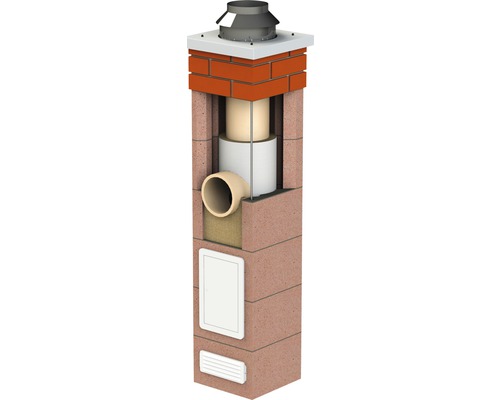chimney
Chimney is a vertical building (or construction) used to discharge flue gases, steam and smoke into the air.
The chimney is mostly used to remove flue gases from buildings. Stoves, furnaces, fireplaces or boilers are connected to it, where it functions as a simple air pump. The hot flue gases in the chimney have a lower density than the air around them, so they rise up the chimney and fresh air is drawn in their place. The pressure that drives air through the chimney is called chimney draft. It depends on the height of the chimney and the ratio of the internal diameter to the volume of flue gases. That is why tall chimneys are built in industrial plants.
The vertical opening in the chimney is called a vent, and the horizontal opening (feeding flues from a boiler, furnace, etc.) is called a flue. Each chimney must have a sweeping and collection opening, and in the case of newer types (gas heating) also an opening for draining condensate. The chimney can also serve as part of the ventilation of the building. Then the draft is caused by the air heated inside the building.
If it is not possible to build a high chimney, or if the chimney is to remove cold gases, devices for artificial draft are installed. An example would be a fan.

Chimney casing is the outer layer of the chimney, which has a protective function. A chimney vent is a mostly round cavity in the chimney, which is used to release gaseous flue gases into the air. The flue is a fixed connection of the flue gas outlet from the appliance to the chimney. The place where the flue pipe is connected to the chimney shell is called the chimney. The extraction hole is used to remove solid parts of the flue gas. The sweeping hole serves to clean the vents. The chimney head is the termination of the chimney above the roof of the building, and the chimney extension is a thin-walled element that extends the effective height of the chimney above its head.
Chimney reconstructions and repairs should be approached continuously not only for safety and compliance with applicable standards, but also for technical progress. Currently, systems are available that take into account the diversity of current appliances and fuels.
The safety of chimneys in the territory of Slovakia is regulated by decree no. 401/2007 Coll., which entered into force in September 2007. It imposes on both natural and legal persons the obligation to maintain the chimney in good technical condition, and its regular inspection and cleaning must also be ensured. Inspections also concern cottages and cottages. The periods for cleaning and checking the chimney depend on the heat output of the appliance and the type of fuel.
